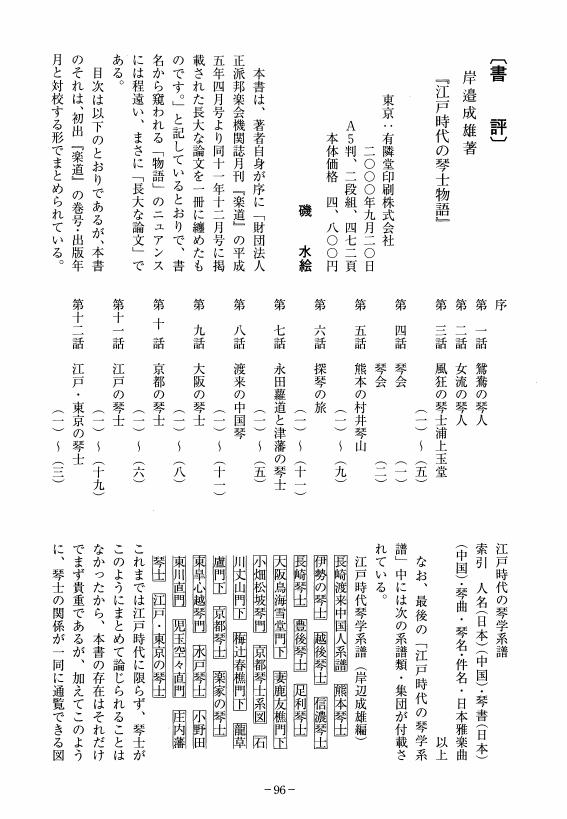4 0 0 0 OA 琵琶秘曲伝授作法の成立と背景
- 著者
- 磯 水絵
- 出版者
- The Society for Research in Asiatic Music (Toyo Ongaku Gakkai, TOG)
- 雑誌
- 東洋音楽研究 (ISSN:00393851)
- 巻号頁・発行日
- vol.1983, no.48, pp.5-41,L1, 1983-09-30 (Released:2010-02-25)
This article has two aims: firstly, to investigate the procedures used in the transmission of secret pieces in the biwa (lute) tradition of the early medieval period, based on the examination of a number of written works describing the details of the ceremony performed for such transmission; and secondly, from the writer's standpoint as a researcher on Bunki-dan (a collection of tales concerning music history and focussing on the biwa, compiled around 1270 by Bunkibo Ryuen, a student of Fujiwara no Takamichi), to undertake a detailed description of the Nishi (lit, west) school of the biwa tradition which was founded by Fujiwara no Takamichi, student of the Myoon'in, Fujiwara no Moronaga (1138-1192), from its initial establishment until its eventual decay.The three manuscripts concerning the ceremony for transmission of secret pieces used as material in this study are as follows:1. Gakka dengyo shiki, myo (a manuscript in the Fushiminomiya collection of the Archives and Mausolea Department of the Imperial Household; also, included in Gunsho ruiju, 2)2. Biwa dengyo shidai (a manuscript in the Fushiminomiya collection of the Historiographical Institute of the University of Tokyo; also in Fushiminomiya gokiroku, 7)3. Biwa dengyo shidai (a manuscript in the collection of the Research Archives for Japanese Music, Ueno Gakuen College)The first manuscript is an Edo-period copy of a copy made by Saionji no Sanekane of the original proceedings of the ceremony written by the Myoon'in (Moronaga); the second is described in its colophon as the procedure handed down by Sanekane to his son Kanesue; and the third is described on its outside cover as being in the hand of Emperor Komyo (emperor of the Northern Dynasty, reigned 1336-1348, died 1380). Aside from the one important distinction concerning the site of the ceremony (i. e. whether it was held at the Myoondo, a temple dedicated to Myoonten [a variant name for Benzaiten, the goddess Sarasvati], or the house of the person receiving instruction into the secret tradition), there is no great difference between the proceedings written in each manuscript. It seems clear that the procedure defined by Moronaga continued to be employed in later centuries.The oldest record in extant historical sources concerning the proceedings of the ceremony is that of Shoji 2nd year (1200), 18th March, when Nijo no Sadasuke transmitted secret pieces to Morisada Shinno. Sadasuke himself was a student of Morinaga's, and it seems likely that the proceedings for the ceremony that he used were based on a precedent set by Moronaga, and that the ceremony itself was probably already an established practice at this time. Inferring from the evidence provided by the three manuscripts above, it is possible to say that the ceremonies practiced in the middle ages were all based on an original formula for the proceedings established at the end of the Heian period by Moronaga. Further inquiries into the later history of the secret piece tradition has shown that its central school was that of the Saionji family, and that two other schools, the Nijo school founded by Sadasuke and the Nishi school founded by Takamichi, existed as side branches.
3 0 0 0 堀河天皇圏の音楽伝承について--楽家の伝承と「続古事談」
- 著者
- 磯 水絵
- 出版者
- 説話文学会
- 雑誌
- 説話文学研究 (ISSN:02886707)
- 巻号頁・発行日
- no.26, pp.p33-54, 1991-06
- 著者
- 磯 水絵
- 出版者
- 二松学舎大学人文学会
- 雑誌
- 二松学舎大学人文論叢 = Journal of Nishogakusha University Humanities Association (ISSN:02875705)
- 巻号頁・発行日
- vol.100, pp.28-57, 2018-03
2 0 0 0 OA 岸邉成雄著『江戸時代の琴士物語』
- 著者
- 磯 水絵
- 出版者
- The Society for Research in Asiatic Music (Toyo Ongaku Gakkai, TOG)
- 雑誌
- 東洋音楽研究 (ISSN:00393851)
- 巻号頁・発行日
- vol.2001, no.66, pp.96-99, 2001-08-20 (Released:2010-02-25)
1 0 0 0 OA 詩歌と舞楽
- 著者
- 磯 水絵
- 出版者
- 全国大学国語国文学会
- 雑誌
- 文学・語学 (ISSN:05251850)
- 巻号頁・発行日
- vol.228, pp.35-47, 2020 (Released:2021-04-25)
- 著者
- 磯 水絵
- 出版者
- 学灯社
- 雑誌
- 国文学 解釈と教材の研究 (ISSN:04523016)
- 巻号頁・発行日
- vol.40, no.12, pp.p66-72, 1995-10
1 0 0 0 「国覔系図」に見る音楽説話の世界
- 著者
- 磯 水絵
- 出版者
- 二松学舎大学人文学会
- 雑誌
- 二松学舎大学人文論叢 = Journal of Nishogakusha University Humanities Association (ISSN:02875705)
- 巻号頁・発行日
- vol.101, pp.23-37, 2018-10
1 0 0 0 IR 駒澤大学仏教文学研究所公開講演会録 鴨長明の晩年 : 日野・醍醐・石清水
- 著者
- 磯 水絵
- 出版者
- 駒澤大学仏教文学研究所
- 雑誌
- 駒沢大学仏教文学研究 (ISSN:13440888)
- 巻号頁・発行日
- no.20, pp.3-21, 2017-02
1 0 0 0 「蘇合四帖」考--『胡琴教録』上より、管絃曲《蘇合》について
- 著者
- 磯 水絵
- 出版者
- 二松学舎大学文学部
- 雑誌
- 二松学舎大学論集 (ISSN:02867206)
- 巻号頁・発行日
- no.47, pp.21-50, 2004
1 0 0 0 関東の雅楽:─鶴岡八幡宮の音楽─
- 著者
- 磯 水絵
- 出版者
- 中世文学会
- 雑誌
- 中世文学 (ISSN:05782376)
- 巻号頁・発行日
- vol.59, pp.25-34, 2014

